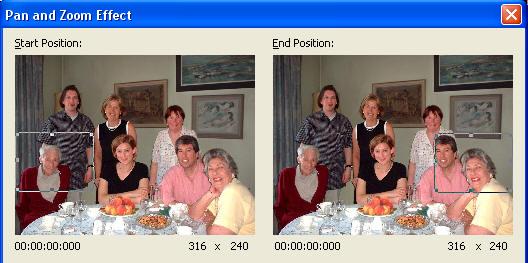Pan and Zoom Effect
The Pan and Zoom Effect, also known as the Ken Burns Effect, allows you to make a sweeping movement across images or video clips. You can sweep across the length and breadth of your video frame, zoom into particular parts and create the illusion that a camera is moving the image.
Start position: The Start position is where the virtual camera will be focused when the effect begins.
The Start position can be specified using the rectangle in the Start Positionbox. Resize and reposition this rectangle to specify the start position.
a) To resize the rectangle, move the mouse pointer over a side or corner handle of the rectangle. When the cursor changes into a double-headed arrow, drag the handle.
b) To reposition and move the whole rectangle, move the mouse pointer inside the rectangle. When the cursor changes into a four-headed arrow, drag the rectangle to the area of the picture that you want to want to be seen when the effect starts.
TIP: If you want to start the effect with the entire frame being displayed, double click inside this rectangle. The rectangle would expands to include the entire frame. You can also specify the size of this rectangle by entering the length and breadth values.
End Position: The End position is the point on the video clip where the panning and zooming will stop.
a) To resize the rectangle, move the mouse pointer to a side or corner handle of the rectangle. When the cursor changes into a double-headed arrow, drag the handle.
b) To reposition and move the whole rectangle, move the mouse pointer inside the rectangle. When the cursor changes into a four-headed arrow, drag the rectangle to the area of the picture that you want to be seen when the effect finishes.
TIP: If you want the pan and zoom effect to end with the entire video image being displayed, double click inside the End Position rectangle. You can also specify the size of the End position rectangle by entering the length and breadth values.
Example:
Consider this family photo. You can use the Pan and Zoom effect to focus on the face of every member briefly, one after the other. To do so, first reposition and resize the Start Position rectangle to include the face of the person present on one end of the frame (the grandfather in this particular example). Now, reposition and resize the End Position rectangle so it includes the face of the person sitting at the other end (the grandmother).

When you play the photo with this effect added to it, it will look as if a camera focused on the photo is tracking from the start position rectangle to the end position rectangle. The focus will pass over the couple sitting in between as well.
If you want to highlight a particular portion of the picture, emphasize it by zooming in on it. Double click on the Start Position box so that the rectangle includes the full screen. Now move the End Position rectangle to the area you want to zoom in on. (In the illustration, the woman in black at the table.) When you play the video, the scene starts with the entire family being shown. The image gradually shifts and narrows to focus on the woman.

By using various resizing and repositioning combinations, you can Pan and Zoom at the same time and also create other stunning effects. The speed of the panning and zooming depend upon the effect duration.
Options
Free form selection: Selecting this option will allow you to specify the Start and End positions without maintaining the aspect ratio of the project. Using this option can result in a distorted (stretched or squeezed) image.
Set end position to be same as the start position: If you select this option, the Start and End position rectangles are set to be identical in size and position. You can then drag the two rectangles freely to create Pan effects, with no Zoom (the magnification of the image does not change).
|